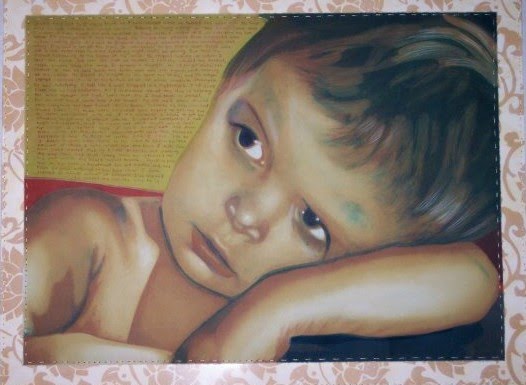Artist's Statement
Everyone has a story to tell. Unfortunately, for people with autism, communication is difficult. Some people on the autism spectrum cannot speak at all. They must rely on sign language, PECS (Picture Exchange Communication System), or even computers to communicate. This can be very frustrating for children. I want to speak for them through my artwork and tell their stories. After all, just because you don't talk doesn't mean you have nothing to say.
My son Derek was diagnosed with autism at the age of 20 months. This literally turned my life upside-down. All of my expectations for parenthood went out the window. I was devastated, but determined to get my son "back." I dropped everything, did research, and started working with Derek. He had stopped responding to his name and made very little eye contact, so I started with that. Then I worked on milestones that he'd missed, like trying to get him to clap and wave. Progress was slow, but once Derek started ABA (Applied Behavior Analysis) therapy at the age of 2, he began to improve rapidly. Derek is considered non-verbal, so the language barrier has been one of our biggest challenges. His receptive language is limited. His therapists and I had to teach him that words had meaning with flashcards. Derek has begun to speak some in the past year, but he has a hard time pronouncing words correctly. When he does speak, he is often misunderstood. Derek cannot speak for himself. I am literally his "voice."
I have been an artist for as long as I can remember. I became a printmaker in college and fell in love with making monotypes. I love the effect I can create by layering colors on top of each other. Making a monotype is hard to explain, but it is relatively simple to do and there is a lot of freedom to the approach. The artist can work either positively or negatively and use either oil based inks or water based inks. They can also incorporate other materials if they want to. I work negatively with oil based ink.
To make a monotype the main things an artist needs is a plate, some ink, an etching press, and heavy-weight printmaking paper. I use Plexiglas for a plate and lithography or etching inks. The paper I use varies. Then I use a large rubber roller to apply a transparent layer of colored ink to a sheet of Plexiglas. I use rags and cotton swabs to wipe away the areas that I will want to remain white on a sheet of printmaking paper. It is like doing a painting in reverse. I do this every time I want to add a layer of color, and sometimes I add up to 10 colors. An artist could also paint directly on the plate with a paintbrush, toothbrush, sponge, or whatever else they could imagine if they wanted to get an interesting effect! Then, a few weeks later when the image is dry, I manipulate the image by sewing other prints (usually etchings or screen prints; sometimes handprints and footprints), paper, and other materials onto my pieces.
I also thought it was important to include artwork by some of the children. Since they have a hard time communicating, sometimes it is easier for them to express themselves through artwork than it is for them to speak. They are able to say things that they cannot say verbally. For instance, Derek's snake picture: most of the time when Derek paints I assume he is just painting to paint. When he painted the snakes, he picked up my hand, put it near the paper, looked at me, and said, "Sssssssss." That is what he says for "snakes." For the first time ever, I knew what my son had painted. It was an amazing moment because my son was able to tell me something he couldn't say in words.
1/110 children are diagnosed with autism now. But those are just numbers. One of my main goals with this project is to put real names and faces to these numbers. Autism is extremely common, yet no parent ever expects to have an autistic child of their own. There is no cure for autism. There is no treatment or therapy or magic pill that is guaranteed to help improve the "symptoms" of autism. Having an autistic child is difficult. It's not just about the medical bills or the time invested in hours of speech, occupational, and physical therapy. It is learning how to love a child who cannot tell you they love you in return. It is watching your child fall behind his peers and learning to cherish every single milestone he or she reaches--no matter what age they reach them. It is finding joy in simple things, like watching water come out of a fountain or watching birds fly, because your child finds them fascinating. I would like to help raise awareness and pinpoint some of the more common autistic "traits" through my pieces so that the general public isn't as quick to judge when they see a kid having a meltdown in a supermarket or if they see a kid flapping his hands when he or she gets excited about seeing a balloon. Autism is not necessarily an illness that needs to be "cured". These children are amazing and extremely intelligent, and each one possess special qualities. I want the world to see these children the way I see them: as beautiful and unique.


